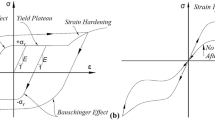Abstract
Damper is frequently used to suppress panel vibration and related vehicle interior noise. Unlike an unconstrained damper, a method to find material properties of a constrained damper is more complicated. This study presents a verified method for obtaining material properties of a constrained asymmetrical damper. The most important material parameters of this constrained damper are shear modulus, shear factor, and of course damping loss factor. The paper provides newly corrected equations to give proper numerical values of these parameters. The difference of natural frequencies between the test and the simulation using the estimated values is about 2 %, which shows that the estimation method is correctly presented. Important characteristics such as shear motion and wavelength of a composite beam constrained by a damper are also investigated. Finally, vibration response of a vehicle roof with a constrained damper is measured and is compared to the simulation. It is noticed that the correlation is much improved, comparing with the simulation based on old material properties.
Similar content being viewed by others
Abbreviations
- g :
-
shear parameter
- k :
-
wavenumber, rad/m
- E :
-
Young’s modulus, Pascal
- G :
-
shear modulus, Pascal
- H :
-
thickness, mm
- I :
-
area moment of inertia
- L :
-
length of beam, mm
- η :
-
damping loss factor
- ω :
-
angular frequency, rad/s
- ρ :
-
density, kg/m3
- 1, 2, 3:
-
layer id
References
Akanda, A. and Onsay, T. (2003). Material property characterization of foilback damping treatments using modified ASTM equations. SAE Technical Paper No. 2003-01-1585.
American Society of Testing & Measurement Standards (ASTM E 756-05). (2010). Standard test method for measuring vibration-damping properties of materials.
Cremer, L. and Heckl, M. (2013). Structure-borne Sound: Structural Vibrations and Sound Radiation at Audio Frequencies. 2nd edn. Springer Science & Business Media. Berlin, Germany.
Harrison, M. (2004). Vehicle Refinement: Controlling Noise and Vibration in Road Vehicles. Elsevier Butterworth-Heinemann. Oxford, UK.
Hur, D. J. and Lee, D. C. (2004). Optimal design of the multilayer damping materials using equivalent modeling. Int. J. Automotive Technology 5, 3, 189–194.
Hwang, H. D., Maxit, L., Ege, K., Gerges, Y. and Guyader, J. L. (2017). SmEdA vibro-acoustic modeling in the mid-frequency range including the effect of dissipative treatments. J. Sound and Vibration, 393, 187–215.
Kerwin Jr., E. M. (1959). Damping of flexural waves by a constrained viscoelastic layer. J. Acoustic Society of America 31, 7, 952–965.
Lee, K. H. and Kim, C. M. (2005). Application of viscoelastic damping for passive vibration control in automotive roof using equivalent properties. Int. J. Automotive Technology 6, 6, 607–613.
Maxit, L., Guyader, J. L., Ege, K., Gerges, Y., Hwang, H. D. and Sandier, C. (2018). SmEdA vibro-acoustic modeling of a trimmed truck cab in the mid-frequency range. In 10th Int. Styrian Noise, Vibration & Harshness Congress: The European Automotive Noise Conf. Graz, Austria.
Meirovitch, L. (1975). Elements of Vibration Analysis. McGraw-Hill. New York, NY, USA.
Nashif, A. D., Jones, D. I. and Henderson, J. P. (1985). Vibration Damping. John Wiley & Sons. Hoboken, NJ, USA.
Torvik, P. J. and Runyon, B. D. (2007). Estimating the loss factors of plates with constrained layer damping treatments. American Institute of Aeronautics and Astronautics J. 45, 7, 1492–1500.
Author information
Authors and Affiliations
Corresponding author
Additional information
Publisher’s Note
Springer Nature remains neutral with regard to jurisdictional claims in published maps and institutional affiliations.
Rights and permissions
About this article
Cite this article
Yoo, J.W., Seo, S.H., Park, J.H. et al. Material Property Identification of Damper Constrained by Thin Foil and Its Application to an Automotive Vehicle. Int.J Automot. Technol. 22, 863–869 (2021). https://doi.org/10.1007/s12239-021-0078-3
Received:
Revised:
Accepted:
Published:
Issue Date:
DOI: https://doi.org/10.1007/s12239-021-0078-3



